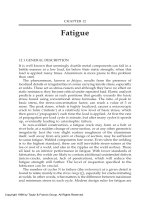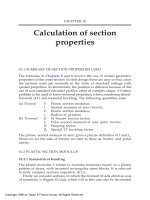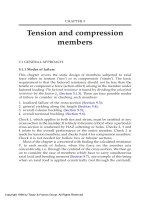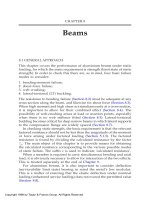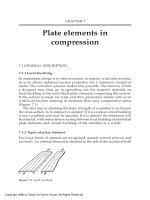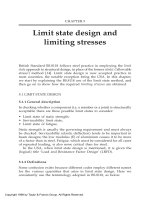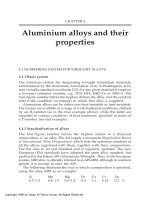Construction delays chapter twelve home office overhead
Bạn đang xem bản rút gọn của tài liệu. Xem và tải ngay bản đầy đủ của tài liệu tại đây (926.75 KB, 16 trang )
CHAPTER TWELVE
Home Office Overhead
WHAT IS HOME OFFICE OVERHEAD?
In the event of an owner-caused delay, a contractor may seek to
recover delay costs associated with home office overhead. For many reasons, despite being a commonly sought element of delay costs, home
office overhead remains a contentious issue. The reasons given for opposition to payment of home office overhead as a cost of delay are many, but
most can be categorized as follows:
• Some do not agree that there is a home office overhead cost incurred
by the contractor as a result of a delay or that any cost incurred is the
contractor’s risk and not the owner’s responsibility.
• Some believe that the home office costs associated with a delay are
fully compensated by the markup for overhead provided on the cost of
the change that caused the delay or on the other delay costs being
sought.
• Some disagree with the formulas that are often used to calculate home
office overhead costs.
Adding to the potential for conflict is the question of what constitutes
home office overhead, a term that can take on different meanings given
the financial structure of the contractor’s organization and the accounting
principles employed. Commonly, however, home office overhead consists
of the contractor’s fixed costs of operating its principal or home office.
It is in the home office that executive and administrative functions are
performed on behalf of the contractor’s entire organization, including
individual projects. Examples of such costs are shown in Fig. 12.1.
Specifically excluded from this definition of home office overhead are
the direct costs of labor, equipment, and materials expended to construct
and manage a specific project. The cost of providing a job site trailer,
e.g., is not a home office cost as it is incurred specifically to support a
particular project.
Construction Delays.
DOI: />
Copyright © 2018 Trauner Consulting Services, Inc.
Published by Elsevier Inc. All rights reserved.
289
290
Construction Delays
Figure 12.1 Example of home office costs.
The auditing or accounting standards employed by the owner can further restrict the definition of home office overhead. For example, under
contracts governed by Federal Acquisition Regulation (FAR) cost principles, certain costs, such as those expended for marketing and entertainment may not be recoverable as home office overhead costs. As a result,
on Federal projects, or on projects that rely on the FAR for the purposes
of cost accounting, these marketing and entertainment costs end up being
covered by whatever amounts the contractor is able to mark up its costs
for profit, if at all.
Regardless of the exact nature of its home office overhead, a contractor must pay for these costs by drawing funds from the projects it
performs. There are many ways for a contractor to do this. Many
apportion home office costs to projects based on some appropriate
measure. For example, home office costs might be allocated to a project based on the project’s revenues or billings. Another contractor
might apportion home office costs based on the contractor’s project
labor costs.
Home Office Overhead
291
Figure 12.2 Percent of home office overhead costs absorbed by each project.
Normally the contractor includes home office overhead costs as a part
of its pricing for each project. For projects that require the contractor to
prepare a lump sum bid price, the contractor often calculates the final bid
price by adding a markup percentage to the direct costs in its bid to provide for home office costs. The exact markup depends on the contractor’s
historical home office overhead costs, which the contractor typically evaluates on a quarterly or an annual basis. When reviewing a contractor’s bid
documents, this markup is often identified as “G&A” for “General and
Administrative” costs. It might also be identified as “G&A&M,” where
the “M” stands for marketing expenses.
The number of projects the contractor has under construction at any
one time may also affect the markup. For instance, if a contractor works
on only one project at a time, 100% of the home office costs for the
period of construction would have to be covered by the project. As the
number of projects increases, the percentage allocated to each job would
be reduced, as shown in Fig. 12.2.
EFFECTS OF DELAYS ON HOME OFFICE COSTS
As just mentioned, a contractor typically includes in its bid price
for a particular project a percentage markup through which it will recover
some portion of its home office overhead. If this project were to then
experience a delay, project revenues may be earned over a longer period
of time, disrupting the basis under which the contractor originally allocated its home office overhead costs. This effect can best be demonstrated
through a series of examples.
292
Construction Delays
One project at a time
For the contractor who performs one project at a time, the effect of a delay
is relatively straightforward. As shown in Example 12-1, the contractor did
not receive additional compensation for extra work on change orders to offset the increase in home office costs to be covered by this project. If, however, the 1-month delay was the result of extra work with direct costs of
only $10,000, and the overhead markup allowed by the contract was 10%,
the contractor would receive $1000 for overhead as compensation for the
extra work. This overhead markup would have to cover both field and
home office overhead. If actual home office overhead costs were $4000 per
month, the contractor would be $3000 short in recovering home office
costs and have nothing left to cover field overhead costs. Of course, if the
value of the change was $100,000, the 10% markup would be greater than
the overhead costs incurred. By their nature, markups are not intended to
compensate the contractor for its actual overhead costs. Sometimes compensation provided by markups will be higher and sometimes lower than the
actual cost incurred. The difference between delays caused by a suspension
and those that result from extra work are addressed later in this chapter.
Example 12-1. A contractor has home office costs of $48,000 per year
and has one, 1-year contract with a value of $1,000,000. The project
experiences a 1-month delay during which time home office costs of
$4000 accrue. (Many home office costs are roughly constant month to
month. If the contractor’s home office costs are $48,000 per year, then
they are likely averaging approximately $4,000 per month.) If the delay
were the result of a full suspension of project work and the delay was
compensable, the contract amount of $1,000,000 would remain the same,
but the contractor would now have to cover a total home office cost of
$52,000 over the term of the contract, an increase of $4000.
Contract amount: $1,000,000
Yearly home office costs: $48,000
Unchanged contract amount: $1,000,000
New home office expense, including extending the project 1 month:
$52,000
Increase in home office costs to be covered by this project:
$52,000À48,000 5 $4000
Based on this example, the contractor would seek $4000 to cover its
home office costs for the delay.
Home Office Overhead
293
Multiple projects
As shown in Example 12-2, the contractor has multiple ongoing projects.
Clearly as the number of projects increases, the calculations become more
difficult, as is apparent from the numerous books, legal briefs, articles, and
web entries related to this subject. In characterizing home office overhead
costs, some choose to distinguish between the terms extended home office
overhead and unabsorbed home office overhead. The calculation of costs for
each may differ, but in practice, courts and boards have not always maintained a clear distinction between these terms. This chapter will treat these
costs as being essentially the same. The remainder of this chapter presents
methods for calculating delay costs associated with home office overhead.
Example 12-2. This contractor has home office overhead costs of
$1,000,000 per year. The contractor normally has four projects in progress at any one time, for a total yearly volume of $20,000,000. The contractor allocates home office costs by adding a 5% markup to each bid.
Each of the four projects is valued at $5,000,000. What would happen if
one project were to experience a delay?
Originally each project absorbed $250,000 of home office costs, or about
$21,000 per month. If one project experiences a 1-month delay due to a full
suspension of work on the project, then the contractor would receive no
additional revenue to cover home office costs from that project, and would
therefore suffer a net loss in recovered or “absorbed” home office overhead
costs of $21,000. If the delay were attributable to added work rather than a
suspension, then the contractor might receive compensation from the overhead markup allowed on the change order. However, in the absence of extra
work, the project experiencing this delay may underabsorb its share of the
home office costs, leaving the other projects to overabsorb these costs.
EICHLEAY FORMULA
The difficulty in precisely establishing the home office overhead
costs due to delay has led to the development of formulaic approaches to
determining the appropriate compensation to be provided to reimburse a
contractor for its unabsorbed or underabsorbed home office overhead
294
Construction Delays
costs. One such method is the Eichleay Formula. The formula originated
from a decision by the Armed Services Board of contract Appeals in 1960
(Eichleay Corporation, ASBCA 5183, 60-2 BCA 2688). In its appeal
before the Board, the Eichleay Corporation proposed a formula for calculating its costs for home office overhead during a delay. The Board
accepted this formula, which has since become known as the Eichleay
Formula, as a reasonable method of calculating such costs.
The Eichleay Formula is a simple three-step formula. First, the total
contract billings are divided by the total actual company billings for the
contract period, as shown in Fig. 12.3. The quotient is then multiplied
by the total home office overhead costs during the actual contract period
to produce the allocable overhead. Next the allocable overhead is divided
by the actual number of days of contract performance, including the
delay. This produces the daily allocable overhead rate (Fig. 12.4). Finally,
in Fig. 12.5, the daily allocable overhead rate is multiplied by the number
of days of compensable delay to produce the home office overhead costs.
A short example illustrates the application of the formula. A company
has total billings of $50,000,000 during the contract period. The contract
billings total $5,000,000. Total home office overhead is $1,000,000 during
the contract period. The actual project duration and the contract period
total 200 days, and compensable delays total 30 days. The first calculation
to produce the allocable overhead of $100,000 (Fig. 12.6) is as follows:
The next calculation produces the daily allocable overhead rate
(Fig. 12.7). And, finally, in Fig. 12.8, the daily allocable overhead rate is
Figure 12.3 Eichleay Formula: Allocable overhead calculation.
Figure 12.4 Eichleay Formula: Daily allocable overhead rate calculation.
Figure 12.5 Eichleay Formula: home office overhead damage calculation.
Home Office Overhead
295
Figure 12.6 Eichleay Example allocable overhead calculation.
Figure 12.7 Eichleay Example daily allocable overhead rate calculation.
Figure 12.8 Eichleay Example home office overhead damage calculation.
multiplied by the number of days of compensable delay to yield home
office overhead costs of $15,000.
Problems with the Eichleay Formula
While the Eichleay Formula is simple to apply, some have questioned its
accuracy. The Eichleay Formula is an estimated allocation and may, therefore, yield results that are either too high or too low. Despite this limitation, the Federal courts and Boards have, for the most part, accepted the
formula as a reasonable approximation of the damages sustained. With less
case law to draw upon, state courts have been less receptive to outright
acceptance of the formula.
Debate over the use of the formula has led to refinements regarding
its application. For example, in Excavation-Construction, Inc., ENG
BCA 3851 (1984), the Engineering Board of Contract Appeals (ENG
BCA) recognized the use of the Eichleay Formula to determine the cost
not only of a suspension of work but also of a delay caused by extra
work. The Board’s opinion is noted in the following quote. The Board
did, however, subtract from the Eichleay calculation the amount of overhead that was already being paid by virtue of the markup on the change
order.
296
Construction Delays
The Board believes in general that an Eichleay-type approach is the preferred
way to determine home office overhead in a suspension situation and that a
markup of direct costs is the preferred way to determine home office overhead
for a change. However, no automatic approach can be applied in avoidance of
a careful scrutiny of the facts. In this appeal, the changed work on the retaining
walls is only part of the reason for extension of the contract period. Much of
the delay and disruption occurred because the change was not timely made.
The parties have agreed that the net effect was to extend the period necessary
for performance by 99 days. Measurement of the effect on home office overhead by the costs alone is likely in these circumstances to understate the
amount to which E-C is entitled. Therefore, the Board considers this appeal to
be a proper one for application of the Eichleay Formula.
The Armed Services Board of Contract Appeals’ response in George
E. Jensen Contractor, Inc., ASBCA No. 29772 (1984), is as follows:
Finally, the Government argues that the home office or extended overhead costs
are fixed costs which would have been incurred even if there had been no delay.
Its argument continues that to allow relief by utilizing the Eichleay Formula
would permit recovery of overhead costs much greater than the direct costs
incurred during the periods of delay. This argument misses the point. Home
office expenses are indirect costs usually allocated to all of a contractor’s contracts based upon each contractor’s incurred direct costs. When a government
initiated delay causes a contractor’s direct costs to decline greatly, that contract
does not receive its fair share of the fixed home office expenses. The Eichleay
Formula is one method approved by boards and courts over a long period of
time which corrects this distortion in the allocation of these indirect expenses.
The most common argument against the use of the Eichleay Formula
is that the contractor receives compensation for home office overhead by
virtue of the markup on a change. However, a criticism of this argument
is that a contractor likewise receives this same markup whether the
change causes a delay or not.
Unless the markup clearly contains an allocation for home office overhead, the argument that Eichleay should not be used may not be valid.
The following quote shows how the ASBCA addressed the point in
Shirley Contracting Corporation, ASBCA No. 29848 (1984):
We find no support for this position. The Corps’ Area Engineer testified that he
did not know the composition of the 15 percent allowed but nonetheless
approved it as a matter of course. He also admitted that the 15 percent overhead was allowed even ‘on modifications that involved no delay at all.
Arguments against the broad application of Eichleay are provided in
P.J. Dick Inc., Appellant, v. Anthony J. Principi, Secretary of Veterans
Home Office Overhead
297
Affairs, Appellee. Nos. 02À1290, 02À1401, April 07, 2003. The United
States Court of Appeals decided in part, as follows:
In short, a court evaluating a contractor’s claim for Eichleay damages should
ask the following questions: (1) was there a government-caused delay that was
not concurrent with another delay caused by some other source; (2) did the contractor demonstrate that it incurred additional overhead (i.e., was the original
time frame for completion extended or did the contractor satisfy the Interstate
three-part test); (3) did the government CO issue a suspension or other order
expressly putting the contractor on standby; (4) if not, can the contractor prove
there was a delay of indefinite duration during which it could not bill substantial
amounts of work on the contract and at the end of which it was required to be
able to return to work on the contract at full speed and immediately; (5) can
the government satisfy its burden of production showing that it was not impractical for the contractor to take on replacement work (i.e., a new contract) and
thereby mitigate its damages; and (6) if the government meets its burden of production, can the contractor satisfy its burden of persuasion that it was impractical for it to obtain sufficient replacement work. Only where the above exacting
requirements can be satisfied will a contractor be entitled to Eichleay damages.
On the subject of suspension, the Court wrote:
Our case law clearly requires that the contractor must show a suspension,
whether formal or functional, of all or most of the work on the contract.
Explaining this statement further, the Court added:
As to PJD’s factual arguments, those too must fail. The Board found that “[t]he
evidence before us shows conclusively that PJD was able to progress other parts
of the work during the time periods it alleges it was suspended.” Although PJD
argues the evidence shows its direct billings were greatly diminished during the
delays, substantial evidence supports the Board’s finding. The evidence, at worst,
shows that in one of these delay periods PJD billed 53% less than it had the
month before. There is, however, no evidence whatsoever that PJD’s direct billings were less than they would have been absent the suspensions-that is the
controlling test. A comparison of pre- and intradelay billings or intra- and postdelay billings is not the test. Regardless, PJD’s direct billings during the delay
periods can hardly be characterized as “minor.” See Altmayer, 79 F.3d at 1134.
At worst, PJD’s direct billings during one of the periods of suspension were 47%
of what they were in prior months; thus, PJD continued to perform substantial
amounts of work on the contract during the suspension periods. On these facts,
which are supported by substantial evidence, we must affirm the Board’s conclusion that PJD was not on standby.
Based on these examples, recovery of unabsorbed home office overhead costs using an Eichleay Formula is not automatic. Like all claims for
delay costs, to recover home office overhead costs, the contractor must
298
Construction Delays
first establish that the delay was indeed compensable. This typically entails
establishing that the delay was on the critical path, delayed the project
completion date, was the owner’s fault or responsibility, and could not
have been reasonably anticipated or otherwise mitigated by the contractor. In addition, many courts that have accepted the Eichleay Formula
have attached other prerequisites to its application. These may include the
contractor establishing (1) an owner-imposed suspension of all or nearly
all of the work on the project, (2) an owner requirement that the contractor be on standby during the associated delay, and (3) proof that while on
standby, the contractor was unable to take on additional work.
When to apply the Eichleay Formula
Based on the examples presented, it may be evident that the Eichleay
Formula is a calculation applied at the end of the project after all of the
delays have occurred and the work is completed. If the parties attempt to
resolve the question of home office overhead during the project, some
form of a modified Eichleay Formula may be appropriate. One approach
is to apply the Eichleay Formula from the beginning of the project up to
the point of negotiations. In this situation, the total contract billings, the
total company billings, the total home office overhead costs, and the total
number of days from the start of the project up to the approximate date
of the calculation may be used. However, there has been reluctance on
the part of the Federal Boards and courts to accept the use of a “modified” Eichleay Formula. But, by the time such disputes get to an actual
trial, the project will have long been completed and there is no longer a
need to use a modified formula.
As noted earlier in this chapter, when using the Eichleay Formula in
Federal government cases, because of the FAR, some costs (such as advertising, entertainment, interest, etc.) that might be included as home office
overhead costs are not allowable. The government will normally disallow
these costs during its audit procedures. In its contract, the Federal government has the right to audit a contractor’s records. For delay claims in
excess of $100,000, the government will often perform an audit.
Other jurisdictions, such as at the state and municipal level may or
may not allow recovery for unabsorbed home office overhead or may or
may not allow the use of the Eichleay formula. For example, New York
State Courts have rejected the Eichleay formula and prefer, instead, a formula known as the Manshul formula. In addition, many jurisdictions
Home Office Overhead
299
throughout the country have no applicable case law addressing the contractor’s entitlement to recovery of home office overhead or the use of
the Eichleay formula. Because of this, for many owners and contractors,
it may make sense to address the recovery of home office overhead by
referencing or providing applicable formulas in the contract. At a minimum, at least for public owners, referencing the applicable FAR regulations governing the determination of allowable home office overhead
costs may be advisable. The exclusion of marketing, entertainment, and
other precluded costs is not without reason. Most public agencies have
formal procurement systems that do not require or allow contractors to
entertain or market government officials in order to get work. For this
reason, it is not unreasonable for public owners to object to paying even
a portion of such costs in the event of an owner-caused project delay.
Home office overhead costs in a delay situation can represent a significant percentage of the overall delay costs. Owners should carefully consider this fact in drafting their construction contracts. Some owners
address this issue by defining in the contract the allowable costs for delays,
including a computation for home office overhead, if any.
CANADIAN METHOD
An alternative method of calculating home office overhead costs for
a delay is known as the Canadian Method. The Canadian Method uses
the contractor’s actual markup for overhead in its calculation. This markup
is based on either the project bid documents or an audit of the contractor’s
records. An audit would reveal the historical percentage markup for home
office overhead applied to each project. Fig. 12.9 shows that the percentage markup is multiplied by the original contract amount and then divided
by the original number of days in the contract. This yields a daily overhead
rate based on the amount the contractor bid. This rate is then applied to
the number of days of compensable delay, as illustrated in Fig. 12.10.
If the delay is significant (a couple of years, for example), then the
daily rate may be escalated to account for an inflationary increase in
Figure 12.9 Canadian Method: Daily overhead rate calculation.
300
Construction Delays
Figure 12.10 Canadian Method: Home office overhead damage calculation.
Figure 12.11 Canadian method calculation example.
overhead over time. For example, say a project is bid for $5,000,000, and
the contracted duration is 500 days. Based on the original bid documents,
the overhead markup is 10%. Multiply the contract amount, $5,000,000,
by the percent overhead, and divide by the number of days to determine
the daily overhead rate, $1000 per day, as shown in Fig. 12.11. The daily
overhead rate of $1000 per day is then multiplied by 50 days to determine
the overhead for the delay period, $50,000.
Because typically no consideration is given to unallowable costs, the
Canadian Method is simpler to apply than the Eichleay Formula. However,
despite this simplicity, it has not been widely used in the United States.
A variation of the Canadian Method, known as the Hudson Method,
has been used. In this method, the percentage markup portion of the formula includes a profit allocation. As with any method, the contractor
must demonstrate that the underlying markup and cost assumptions are
reasonable before recovery under these alternate methods will be allowed.
ALLEGHENY FORMULA
The Eichleay Formula, Canadian Method, and similar formulas and
methods have their most obvious application to a delayed contractor working
Home Office Overhead
301
on a construction project. However, these formulas can be problematic
when applied to a manufacturer or fabricator. Though the issue is still underabsorption, the effect of the delay may be more difficult to evaluate.
To understand this problem, consider a steel fabricator. The fabrication facility represents a huge capital investment with substantial ongoing
operating costs that must be recovered through the fabrication and delivery of structural steel components to many construction projects.
Typically, fabricators “schedule” their fabrication facilities, with each
project being assigned a “window” of time during which fabrication is
planned to occur. If the approval of the steel shop drawings is delayed
because of a design error or for some other reason that is the owner’s fault
or responsibility, the fabricator may not be able to fabricate the affected
project’s steel in the anticipated window. This may result in the fabricator
rescheduling work in its fabrication facility. In the best case, this rescheduling is simple—the project that is not ready for fabrication is moved
later in the year and another project is moved up to fill the “hole” left by
the rescheduled project. In the end, the fabrication facility is fully utilized
and the costs of owning and operating this facility are covered by the
amounts bid for the work.
But it is also possible that bumping the delayed project’s steel fabrication work to a later fabrication window will leave the fabrication facility
underutilized during the project’s planned fabrication window, particularly if there is a lot of steel to be fabricated. The Eichleay Formula is not
designed to calculate the resulting underabsorption. It is more applicable
to the evaluation of the underabsorbed home office overhead costs of a
project. Also, the issue is not really so much one of delay as it is of underabsorption. The problem for the fabricator is not that the fabrication
window slipped a month, the problem is that its fabrication facility and
workers were idle or operating at reduced capacity during the originally
scheduled window.
Note, also, that the issue is further complicated by the possibility that
the fabricator may have over-scheduled its fabrication facility or taken on
replacement work to keep the fabrication facility busy, mitigating the
underabsorption.
For manufacturers and fabricators, the more appropriate formula to
use for this set of facts is likely to be the Allegheny Formula. That is
because the Allegheny Formula is based on a comparison of overhead
rates, not on the duration of the delay. In fact, the duration of the delay is
not a number used when calculating underabsorbed home office overhead
using the Allegheny Formula.
302
Construction Delays
To understand how to use the Allegheny Formula, consider the following example:
Example 12-3. A steel fabricator is awarded a project. In accordance
with the schedule for the project and its agreement with the general contractor, the fabricator schedules the fabrication window for the structural
steel for the project for the month of July. Because of delays that are the
owner’s fault and responsibility, steel cannot be fabricated during the July
fabrication window and is pushed to the next available window, which is
September of the same year. Though the fabricator is able to reschedule
some of its fabrication work into the July window vacated by the delayed
project, the actual volume of work performed during the month of July
is substantially less than the fabricator’s usual volume and also less than the
volume of work that it could have completed had the delayed project not
missed its July fabrication window.
During the July fabrication window, the planned period of performance, the overhead absorption rate was 20%. This means that the actual
overhead costs divided by the actual cost of labor and materials was 20%.
During an “actual” period of performance (which could be the period
during which the steel was actually fabricated), the overhead rate was
15%. The overhead rate is lower because the overhead costs are being
spread over the “normal” volume of work, not the reduced volume of
work actually performed during the original fabrication window in July.
The underabsorbed overhead cost is calculated by taking the difference
between the overhead rate calculated for the actual period of performance
and the normal period of performance, which is 5%. This difference is
than multiplied by the cost of the delayed contract steel work. This calculation captures the underabsorbed portion of the home office overhead
costs. If the labor and material cost of the contract steel work was
$200,000, then the resulting underabsorbed amount is $10,000.
CALCULATION USING ACTUAL RECORDS
Some owners are reluctant to include home office overhead costs in
compensation for delays. This is particularly true when these costs are
based on a formula (Eichleay, Canadian, Manshul, Allegheny, and many
others) that provides only an approximation of costs. The contractor
Home Office Overhead
303
Figure 12.12 Home office overhead calculation based on actual records.
may be able to strengthen its argument by maintaining accurate records in
the home office that would support its specific claim for costs.
For example, assume a contractor has a home office staff of 20 people.
The staff includes project managers, estimators, schedulers, clerical workers,
and accountants. The company requires that all employees maintain accurate time sheets by activity and by project. This documentation may be useful in supporting the contractor’s request for home office overhead costs
when a delay occurs. In this approach, the contractor can use the records to
determine the staff ’s percentage effort expended, either throughout the
project or during the specific delay period, if appropriate. The time sheets
show the hours the home office staff expended on the delayed project. This
percentage can be applied to the other fixed home office costs to apportion
those to the delayed project. Alternatively, the computation in Fig. 12.12
could also be performed on a salary basis to generate the percentage of
salary expended on the delayed project, as opposed to time.
SUMMARY
Regardless of the method used to calculate home office overhead
costs resulting from delay, it is necessary to demonstrate two fundamental
points. The first is that the contractor actually incurred a cost related to
304
Construction Delays
its home office that was not covered by the contract price due solely to
an excusable and compensable delay. Generally that means that the contractor’s period of performance was extended with no commensurate
increase in revenues from which home office overhead costs for the
extended period were recovered. In some venues, this may be considered to have occurred only in a pure suspension period. In other venues,
the contractor may be able to demonstrate that a large delay during
which only minimal change order or contract work occurred still
resulted in a loss.
The second point is that the method chosen to calculate the underabsorption of home office overhead costs results in a reasonable estimate of
the loss incurred. The most appropriate method will be a function of
many factors, including the type of business the contractor’s company is
engaged in and the historical trends of the company’s revenues and costs.
As with any cost being claimed, the contractor has the burden of demonstrating that it actually incurred a loss of the degree being claimed.

